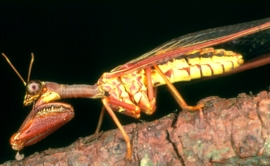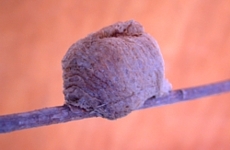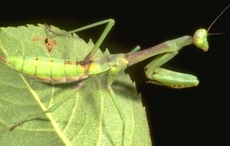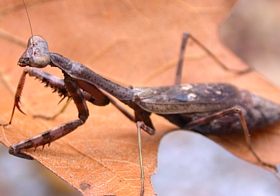|
|
ARTHROPODS:
Insects»
Spiders»
Centipedes»
Millipedes»
Sowbugs»
Harvestmen»
Mites
& Ticks»
Scorpions»
Identification
Tips»
About
the Critter Files»
Links» |
|
|
|
 |
PRAYING
MANTIDS
Critter
Files/Insects/Praying Mantids
By Blake Newton
University of Kentucky Department of Entomology |
| |
|
| Common
Kentucky Praying Mantids: |
| |
| TAXONOMY |
KINGDOM: Animalia
| PHYLUM: Arthropoda | CLASS: Insecta | ORDER: Mantodea (praying
mantids) |
| |
WHAT
IS A PRAYING MANTID?
LIFE CYCLE
ECOLOGY
PEST STATUS
COMMON KENTUCKY PRAYING MANTIDS
COLLECTING & PHOTOGRAPHY
MANTID FACTS
MYTHS, LEGENDS, AND FOLKLORE |
| |
| WHAT
IS A PRAYING MANTID? |
|
Praying mantids are
among the most distinctive insects, with elongated bodies, triangular
heads, and spiny, prey-grabbing "raptorial" front legs
(from the Greek word "raptor," meaning "thief").
Mantids are usually a combination of gray, green, or brown,
depending on the species. Like grasshoppers
and crickets, mantids have
thickened front wings (tegmina) which help protect their delicate
hind wings. Mantids also have chewing mouthparts. Praying
mantids are also called mantises, mantids, and praying mantises.
The only insects sometimes
confused with praying mantids are the walking sticks (order Phasmida)
and the mantidflies (order Neuroptera). Walking sticks, like
mantids, are long and thin, but they do not have raptorial front
legs. Mantidflies are rare insects (related to lacewings)
which resemble small praying mantids. Mantidflies are usually
much smaller than true mantids, and the front wings of mantidflies
are not thickened and protective like the tegmina of mantids. |
| |
 Mantidfly: not
related to true mantids (Image courtesy University of Florida)
Mantidfly: not
related to true mantids (Image courtesy University of Florida) |
|
| SIZE:
Body length of adult mantids up to 4" long. Nymphs are
less than 1/2" upon hatching. |
| |
| LIFE
CYCLE |
|
Like
crickets and grasshoppers, mantids go through a simple metamorphosis,
with egg, nymph, and adult stages. The nymphs resemble small,
wingless adults. After hatching from eggs in late spring,
the predatory nymphs feed and grow through the summer, molting several
times before becoming winged, mature adults. In late summer
and early fall, female mantids attach large egg masses to twigs.
These egg masses often contain hundreds of eggs, and are constructed
with a gluey substance that quickly hardens, providing protection
from birds and other predators.
|
| |
 Praying mantid
egg mass
Praying mantid
egg mass
(B. Newton, 2003) |
 Mantid nymph
Mantid nymph
(R. Bessin, 2000) |
| |
| ECOLOGY |
|
|
Nymph and adult praying
mantids are predators that feed on moths, butterflies, caterpillars,
and other insects. Mantids are ambush predators. They are able to
blend into foliage with their inconspicuous colors and wait for
unsuspecting insects to fly within striking distance of their barbed
front legs. Praying mantids do most of their hunting during the
day, but are sometimes active at dusk. |
 Preying
mantid feeding on a beetle.
Preying
mantid feeding on a beetle.
(B. Newton, 2002) |
| |
| Praying mantids
look tough, but they are not well defended from predators. Despite
their protective coloration, praying mantids are often eaten by spiders,
birds, and larger praying mantids. |
| |
| PEST
STATUS |
|
Praying
mantids do not sting or bite, and are not normally considered pests.
However, the Chinese
mantid and the European mantid are sometimes considered pests because
they are invasive insects, and sometimes feed on native insects,
including native praying mantids. |
| |
| |
| COMMON
KENTUCKY PRAYING MANTIDS |
|
|
CHINESE
MANTID
FAMILY: Mantidae
| GENUS and SPECIES: Tendora aridifolia
The Chinese Mantid,
Tendora aridifolia, is the largest praying mantid in Kentucky,
reaching 4" in length. Because of its large size, it
is one of the most commonly seen mantids as well. Chinese
mantids are usually either bright green, tan, or a combination.
This mantid was introduced to the U.S. from China in the late
1800's as a potential beneficial insect. It is no longer considered
beneficial because it feeds on many desireable native insects, including
butterflies and native praying mantids. |
| |
 Chinese Mantid
(R. Bessin, 2000)
Chinese Mantid
(R. Bessin, 2000) |
|
|
|
CAROLINA
MANTID
FAMILY: Mantidae
| GENUS and SPECIES: Stagmomantis carolina
The Carolina
Mantid, Stagmomantis carolina, reaches about 2
1/2" and has a mottled appearance, with gray, white, black,
and tan. It is the only mantid native to Kentucky. |
| |
 Carolina Mantid
(B. Newton, 2003)
Carolina Mantid
(B. Newton, 2003) |
|
|
|
Not pictured is the
European Mantid, Mantis religiosa. The
European mantid is typically tan or green and closely resembles
the Chinese mantid, but it is smaller on average (2-3"). The
European mantid originated in Europe and was accidentally introduced
to the U.S. in the 1800's. |
|
| |
| COLLECTING
& PHOTOGRAPHY |
|
Praying mantids are
common in Kentucky throughout the late spring, summer, and early
fall. They can be found in weeds, gardens, shrubs, and in
low-laying tree branches in a wide variety of urban, rural, and
natural habitats. Because of their "sit-and-wait"
hunting strategy and their camouflaged color patterns, praying mantids
can be difficult to see. When you find one, though, they are
unlikely to fly away and tend to be easy to catch. They will
also usually stand still and allow you to get close for a good photograph.
|
| |
| MANTID
FACTS |
|
Although praying mantids
have wings, they are clumsy fliers, and do not take to the air often.
Praying mantids are so-called
because they appear to be "praying" when their raptorial
legs are held at rest. Also: "mantes" is a Greek word
meaning "prophet" or "soothsayer." Perhaps the
"contemplative" posture of praying mantids reminded ancient
people of a prophet at work.
Praying mantids have
large eyes for a reason: the many facets in their compound eyes
allow them to see and capture prey as it flies past.
Like praying mantids
and mantidflies, ambush
bugs (Order Hemiptera, Family Reduviidae) also have raptorial
front legs and a sit-and-wait hunting strategy. Despite this
similarity, mantids, ambush bugs, and mantidflies are not closely
related.
Read more about praying
mantids in our Entfact: Praying
Mantids.
|
| |
| MYTHS
- LEGENDS - FOLKLORE |
|
It is often said that
praying mantid females eat males during the mating process. Although
this sometimes occurs, it doesn't always happen: the male is often
able to escape. Read more about this myth at the Urban Legends
Reference Pages:
http://www.snopes.com/critters/wild/mantis1.htm
According to a widespread
myth, it is illegal to kill praying mantids in certain states. This
is not true: praying mantids in the U.S. are not currently in danger
of extinction, and are not protected by any specific laws. However,
it is illegal to kill any animal in certain nature preserves and
wildlife sanctuaries. Could this be how the myth originated?
Read more about this myth on the Urban Legends Reference Pages:
http://www.snopes.com/critters/wild/mantis2.htm
Many people believe that
the praying mantid is a beneficial insect. Although it is true that
mantids sometimes feed on pest insects, they also feed on other
beneficial insects -- including each other. Because of this,
mantids usually do not reduce pest populations.
|
Original document: 25 May 2004
Last updated: 25 May 2004
Photos courtesy R.
Bessin and B. Newton, University of Kentucky, except Mantidfly, University
of Florida; used with permission.
The Kentucky Critter
Files are maintained by Blake Newton, Department of Entomology, University
of Kentucky.
Contact: blaken@uky.edu
|
|

